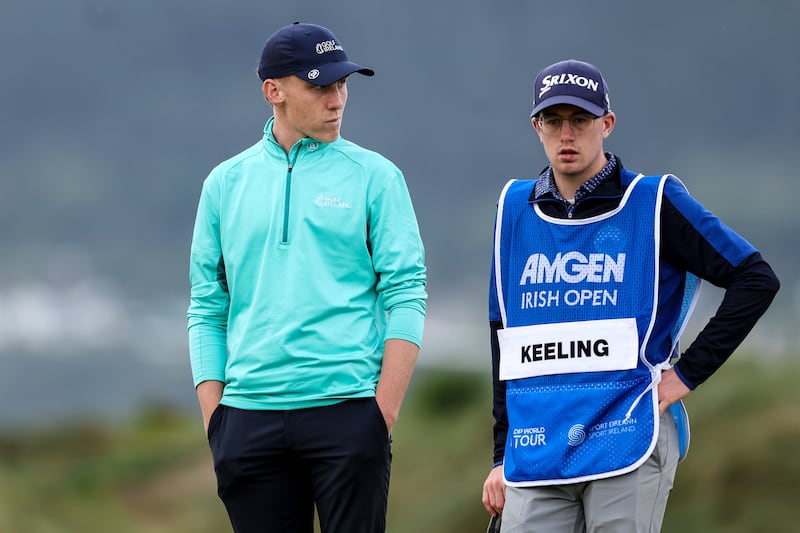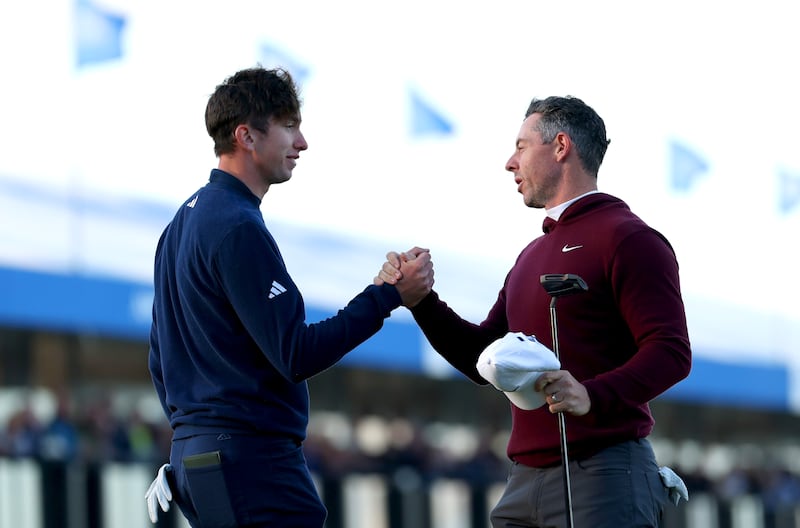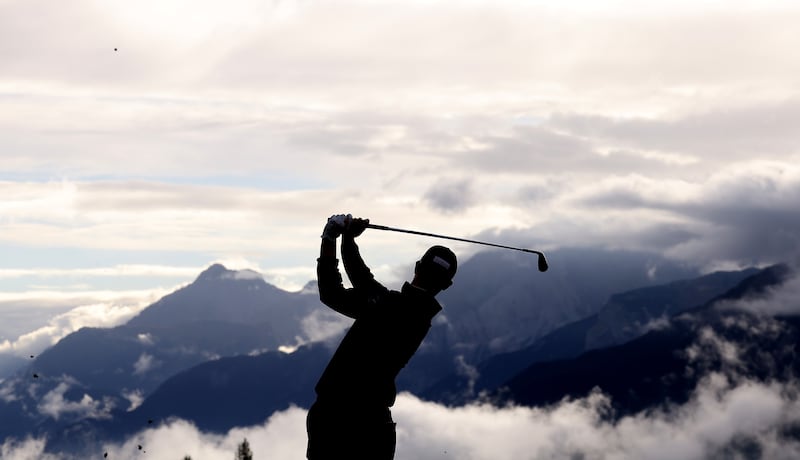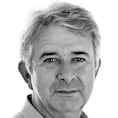At the Irish Open last week Des Smyth spent part of every day at the driving range, an outdoor laboratory where the pros dabble in physics and chemistry. Golf has turned many revolutions since Smyth was on tour, but he is wide-eyed still and open to wonder.
“I was standing behind some of these guys,” he says, “and I didn’t even know their names. I was watching them hit the ball and I was thinking, ‘You can’t hit the ball any better than that.’ And these guys haven’t even emerged yet.”
One morning Smyth stood behind Seán Keeling, a 17-year-old from Roganstown who played for Europe in the junior Ryder Cup and is heading to Texas Tech for his Freshman year. He played in the Irish Open on an invitation and shot a staggering 70 in howling winds on Thursday, one of only two bogey-free rounds in the field. A day later he made the cut.
In an interview with Irish Golfer in May Keeling shared his ambition to play on the PGA Tour and to win majors, none of which had only just occurred to him. Keeling has been playing in the biggest amateur events in Ireland since he was 12 years of age, which carries echoes of Rory McIlroy’s childhood. He has spent some time with McIlroy’s coach, Michael Bannon, and for the last five years he has been working with a sports psychologist.
RM Block
In other walks of life that would be seen as a smart line in futureproofing; in sport, the dice will roll, regardless.
“I met him after he made the cut [in the Irish Open]” said Smyth, “and I said, ‘You’ve done unbelievably well.’ He looks like he’s going to be a great player. Will he become a great player? You know, I can’t answer that.
“I did an interview with Ryan Fox [in Royal County Down]. He’s on the PGA Tour for most of the year now. He said the superstars over there are so exceptional. But the rest of us? There are thousands of us, he said. You’re lying 10th, you drop a shot, you’re tied 25th. You make another error and you’re down to 45th and, he says, nobody even knows you’re there.”

In that line of work, obsolescence is a constant threat. Outside of McIlroy and Shane Lowry, who are global players now, Tom McKibbin is the only home-based Irish player with full exemption on the DP World Tour. Six Irish players reached the final stage of Q-school last year, but none emerged with a card.
How much has the landscape changed? When the Irish Open was staged at Fota Island 10 years ago there were 21 Irish players in the field; last week at Royal County Down, there were 11.
Those numbers are queered partly by changes in the exemption criteria, but of the 21 players who teed it up in Fota Island 10 were full-time on the European Tour, as it was called then. That concentration of talent no longer exists.
There are five Irish players at the BMW in Wentworth this week, the most prestigious event on the DP World Tour; 10 years ago, there were 11 Irish players in the field.
“If you think of Tom McKibbin now, he’s out on tour on his own as such,” says Gary Murphy, who spent 15 years on the European Tour and the Challenge Tour. “Whereas when I went out on tour, I had Des Smyth, Eamon Darcy, Philip Walton, Paul McGinley, Padraig Harrington, Darren Clarke, Ronan Rafferty, Peter Lawrie, Damien McGrane, Gareth Maybin. There were probably five or six elite players in that group to learn and feed off.
“You kind of had your own camp within the tour. The young fellas coming through now don’t have that luxury.”
The nature of professional golf has changed profoundly over the last 20 years. The best European players are now based in the United States and what used to be the European Tour has embraced a different business model, pitching its tournaments on four continents and attracting players from every corner of the globe. The competition for places on the DP World Tour now is fierce and relentless.
“It is a brutal sport,” says Murphy. “You can be on tour, lose your card and within two years have no access to play anywhere. It is exceptionally cut-throat. There’s two ways of looking at it. Are you going to turn professional or are you going to have a career in professional golf? Lots of our kids turn pro, but how many of them are actually having a career in professional golf? How many of them are turning a profit? Very few.”

What is clear is that Irish professional golf, in the men’s game, has lost critical altitude. The golf writer Ronan MacNamara has pointed out that just five Irish players appeared in the top 18 exemption categories on the DP World Tour this year, which put Ireland behind Denmark, Sweden, France, Scotland, Spain, Italy and Germany.
Why should that be the case? Talent pathways in Irish golf are robust and well-resourced and are still producing exceptionally good amateurs. Over the last 10 years 16 Irish players have represented Britain and Ireland in the Walker Cup. On the 2015 team that thrashed the United States there were five Irish players, more than there had ever been.
All of them turned professional. Where are they now? Jack Hume is no longer playing at that level; Gavin Moynihan has been competing on mini-tours this year; Paul Dunne has failed to find his best form after injury and has no status on any tour for 2024, though he is exempt to stage two of Q-school on the DP World Tour. Cormac Sharwin and Gary Hurley are on the Challenge Tour. All of them are talented players. When they turned pro, nobody said they were foolish.
Hurley, Sharwin and four other Irish players teed it up at a Challenge Tour event in Italy this week. There is a hotel on-site charging more than €300 per night for a room, butting heads with the subsistence economy of the tour. Hurley says nobody in the field is staying there. He found something on Airbnb.
“Playing on tour has got a lot more expensive,” says Hurley. “If you have a caddie, that’s another expense. If you want to stay by yourself, and not share, that’s another expense. The prize money is not brilliant. It’s decent if you’re playing well, but if you’re not ... You go and play in Switzerland, or the Nordic countries and it costs you a fortune.”
Since he turned pro in 2015 Hurley has played 83 times on the Challenge Tour and made 31 appearances on the DP World Tour: in those events he has won just over €197,000 in prize money. This season he was one of 10 players to receive a Golf Ireland grant of €33,000, but this is the last time that he can benefit from that scheme.
His fiancee lives and works in Abu Dubai, and this is where Hurley bases himself for the winter, but at this time of the year he goes home to Waterford. Nothing is comfortable or simple or settled. Seamus Power, his clubmate from west Waterford, didn’t make a breakthrough on the PGA Tour until he was 30. Hurley is 31. Not there yet. Not stopping.
“Do I question it? I think everyone does. It’s a very, very hyper variable game and lifestyle. At times you feel like you are doing really good work and it’s not really coming together. You have to be patient and have a good attitude while you’re waiting.
“There are so many aspects to the game. If you get into a bad run of missed cuts, it’s a lonely place. For me, it’s about being happy in what I’m doing, I suppose, which I am at the minute. That’s a big one for me.”

Golf Ireland has a programme to support players in their transition from elite amateur to nascent professional. Individual funding is linked to strict criteria and this year 10 players qualified. Nobody can receive grant assistance more than six times.
Those players have access to bespoke practice facilities in Carton House and a winter practice facility in Portugal; a training base in the UAE will soon be added. Are there enough world class practice facilities around Ireland? No.
For the upcoming academic year a staggering 31 Irish players, male and female, will be on golf scholarships in American universities, and there is hope in those numbers. Over Thanksgiving, a dozen of them will gather in Florida for a training camp with Golf Ireland coaches, just to maintain a link.
Is there other stuff that Golf Ireland could do? Are other federations doing it better? Should there be a better strike rate among elite Irish amateurs who turn pro? Is there a limit to what a federation can do in an intensely individual sport?
Neil Manchip is the high-performance lead for Golf Ireland and has been Lowry’s coach throughout his professional career. He insists their minds are open to new ideas and better practices. “It’s something we want to develop. We’re doing a study at the moment with a lot of different countries around the world, looking at what their amateur to professional schemes are like. There’s a blend between countries who do nothing whatsoever and countries who have really matured programmes.”
In this arena, with a very small budget, the Danish federation has been a shining light. A young Danish player starting out on the Challenge Tour will only receive €1,500 in funding, but their system is a triumph of mentoring and holistic support.
“Our tour players and retired tour players give a lot back, in whatever we facilitate,” says Claus Moelholm, their elite performance lead. “They come and visit our training camps. The Hojgaards are still part of our training camps.”
This season, three Danish players have won on the DP World Tour. Another has won three times on the Challenge Tour. Twenty-five years ago, Danish golf was scarcely mapped.
Outside of two or three household names, Irish men’s golf is in a trough. McKibbin looks like he will win his card on the PGA Tour for next season. Conor Purcell has won on the Challenge Tour this year and is trending towards the DP World Tour. Apart from that? Fighting and scrambling.
Maybe it will never go back to what it used to be. Maybe we were spoiled.























